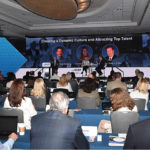It was taking a couple of quick laps (with a driver) in a street-legal race car at the Dallara Indy-Car Factory and event venue, where the chassis for Indianapolis 500 race cars are built.
But there was much more to get excited about during the long weekend, organized around the 2012 NCAA (National Collegiate Athletic Association) Big Ten Championship football game at the 63,000-seat Lucas Oil Stadium. The stadium was the site for another big game you may have heard of — last February’s Super Bowl XLVI — and the visit gave me, along with a group of meeting planners, a chance to see, not only the expanded infrastructure that made Indy one of the most successful Super Bowl hosts ever, but the city’s ongoing development.
My visit began with a hard-hat tour of The Alexander Hotel, scheduled to open this month with 209 guest rooms and 12,500 square feet of meeting space certified by the International Association of Conference Centers (IACC). Even unfinished, the hotel’s public spaces were striking, thanks to floor-to-ceiling windows open to golden late afternoon light. Part of a downtown mixed-use development called CityWay, the Alexander has partnered with the Indianapolis Museum of Art (IMA) to commission 12 site-specific artworks from local, national, and international artists, as part of a collection of about 40 IMA-curated works that will fill the hotel.
Dinner was at the newly opened, warmly elegant Cerulean, also at City-Way. The imaginative menu, which lists the names of the local farms where it sources ingredients, includes entries such as mushroom custard and haysmoked quail with cherry butter, but the dish I found myself talking about all weekend was the spiced peanut-butter ice cream served with banana, caraway, and burnt honey.
I stayed at the JW Marriott Indianapolis, which, at 33 stories with 1,005 rooms, is the largest JW Marriott in the United States. The property features more than 103,000 square feet of meeting space, including a 40,500-squarefoot grand ballroom, an exhibition hall, and 34 breakout rooms. The second-floor meeting space is connected via a walkway to the Indiana Convention Center, which offers 566,000 square feet of exhibit space, plus 71 meeting rooms and three ballrooms. The convention center in turn is linked to Lucas Oil Stadium by a walkway; together, the two venues offer approximately 750,000 square feet of exhibit space.
The convention center is also connected to more than 4,700 hotel rooms — more than any other city in the U.S. That includes those at the newly updated Hyatt Regency, which last year completed a $20-million renovation of its meeting spaces, 499 guest rooms, and revolving rooftop restaurant, The Eagles Nest. The renovation didn’t simply update hotel interiors, but rethought and realigned spaces with how people meet and work today, said General Manager Brian Comes, including outfitting guest rooms with ergonomic work stations and the latest in wireless technology, such as RFID-enabled room keys. We had brunch at The Eagles Nest, where we moved slowly through a panoramic view of the city as Chef John Pivar explained the philosophy behind the restaurant’s seasonal, healthy menus.
After brunch we set out to explore the city’s pedestrian- and bike-friendly Cultural Trail; that very day, city workers were installing the last few pavers in the eight-mile-long trail, which links Indy’s downtown and near-downtown areas, and which has given walkers and bikers — and meeting attendees — a new way to travel the city. The trail’s design — a mosaic of cocoa-colored pavers — is as beautiful as it is functional, and includes $2 million in commissioned public art.
The trail is “now the best way to see Indianapolis,” said Cultural Trail Executive Director Karen Haley on our tour, which started at a new bike hub where bike rentals are available. We pedaled through the Massachusetts Avenue shopping and dining district, where we made stops to browse books, buy locally made chocolates, and admire the art installations before looping back toward downtown.
By mid-afternoon, Georgia Street, a three-block pedestrian boardwalk that debuted during the Super Bowl, was a sea of red and white — the school colors for both the University of Nebraska and the University of Wisconsin, who were battling it out Saturday night for the Big Ten championship. Surrounded by restaurants and entertainment venues, Georgia Street links the convention center with Bankers Life Fieldhouse, home to the NBA’s Indiana Pacers, and Lucas Oil Stadium, home to the NFL’s Indianapolis Colts, to downtown. Portions of Georgia Street can be blocked off and reserved for groups and customized with lighting and tents.
Before kickoff, we squeezed in the visit to the Dallara IndyCar Factory, near the famed Indianapolis Motor Speedway. In addition to tours of the space with Dallara Automobili company engineers, the venue offers more than 30,000 square feet of meeting space.
On Saturday night, the game’s score was far from close — Wisconsin beat Nebraska, 70—31 — which gave us lots of time to enjoy Visit Indy’s hospitality in one of Lucas Oil Stadium’s approximately 140 suites. When not used as a gridiron, the stadium offers 183,000 square feet of exhibit space, plus 12 meeting rooms and many party spaces.
Indianapolis is headquarters to the NCAA, and on Sunday morning, I took a tour of its Hall of Champions and Conference Center in White River State Park, also downtown. The conference center recently has almost doubled its meeting space with the construction of the Brand Building, and now can accommodate groups of up to 550 in theater-style seating. Groups also can reserve the Hall of Champions, including areas with interactive exhibits representing all 23 NCAA sports.
For more information: visitindy.com



